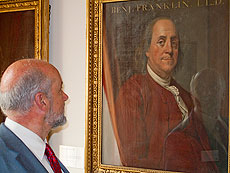An LHC discussion

Fermilab Director Pier Oddone poses with a painting of Ben Franklin, a Royal Society Fellow, at the Royal Society in London.
This morning I chaired the opening session of a discussion on the LHC at the Royal Society in London. Sir Isaac Newton sat to my left, looking onto the audience from a painting. Today's event is one in a long tradition of Royal Society discussions going back about three and a half centuries. The purpose this time was to engage a broader audience on the many facets of the LHC, from its scientific potential for discovery, to the science and engineering of the accelerator, to the technological developments of detectors and computing, and to the social, political and financial aspects of mounting such a global project. The audience included distinguished members of our field, science writers and reporters, scientists from other fields, policy makers and the interested public.
The Royal Society is a fitting venue for this sort of discussion because it invites reflection. Many great minds have been fellows of this society. Near the portrait of Newton (1642-1727) are portraits of two other former society presidents: Lord Ernest Rutherford (1871-1937), who received the Nobel Prize in chemistry in 1908 and is the father of all our scattering experiments and Lord Howard Florey (1899-1968), who as co-discoverer of penicillin shared the 1945 Nobel Prize in physiology and medicine. Fermilab's own Keith Ellis was elected as a Royal Society Fellow in 2009.
The rich history of the Royal Society is evident not only in the lecture hall, but throughout the halls and corridors of the society where remarkable portraits include interesting characters such as the philosopher John Locke (1632-1704), who was hugely influential in establishing that knowledge derives from experience and is not innate. He had broad influence on thinkers of the Enlightment and even the U.S. Constitution. In fact, respect for evidence rather than authority is the motto of the Royal Society, "nullius in verba", Latin for "take nobody's word for it", adopted to signify the Fellows' determination to establish facts via experiments. It would be a good motto on which to base public debate today.
The widely divergent speculations of what we may discover at the LHC will get settled by fact and some of it very quickly. The performance of the LHC is now better than predicted: the beam emittances are lower; the intensity per bunch larger and the beam-beam limit much larger than was assumed in the design, all factors leading to higher luminosity than expected for the given number of bunches. The detectors are working extremely well and we are at the threshold of important results not only from the Energy Frontier detectors such as ATLAS and CMS, but also in heavy-ion collisions from ALICE and b-physics from LHCb. The grid-based computing is extremely capable and keeps up with data collection and analysis. It is indeed a remarkable achievement to have brought the world together in this voyage of exploration.
The discussion at the Royal Society is very lively and touches on all aspects of the LHC in an accessible way. It is worthwhile for us to think about holding such a broad meeting in Washington, D.C. that would help policy makers and the public understand what it will take for the U.S. to lead a competitive global project.
|